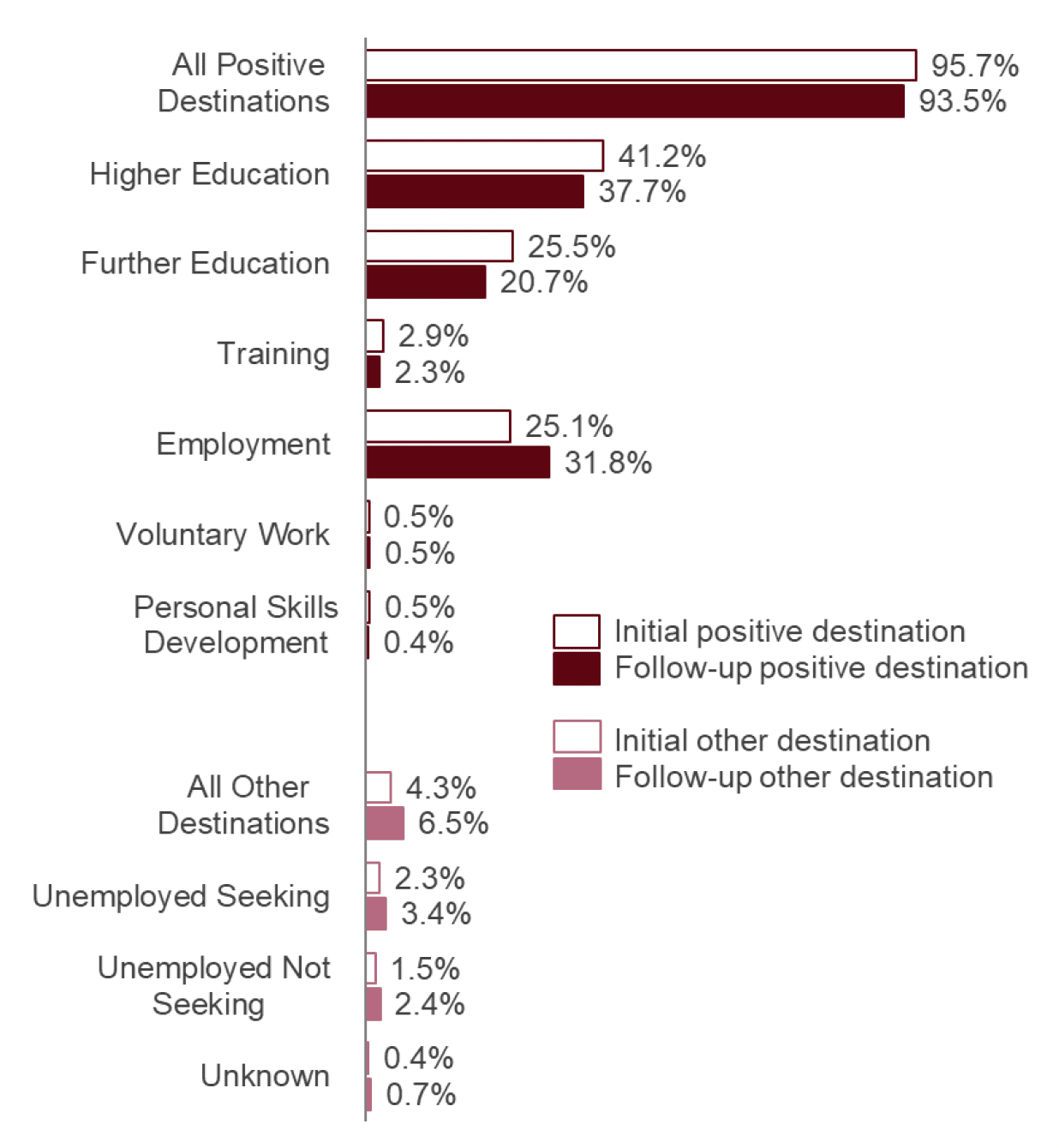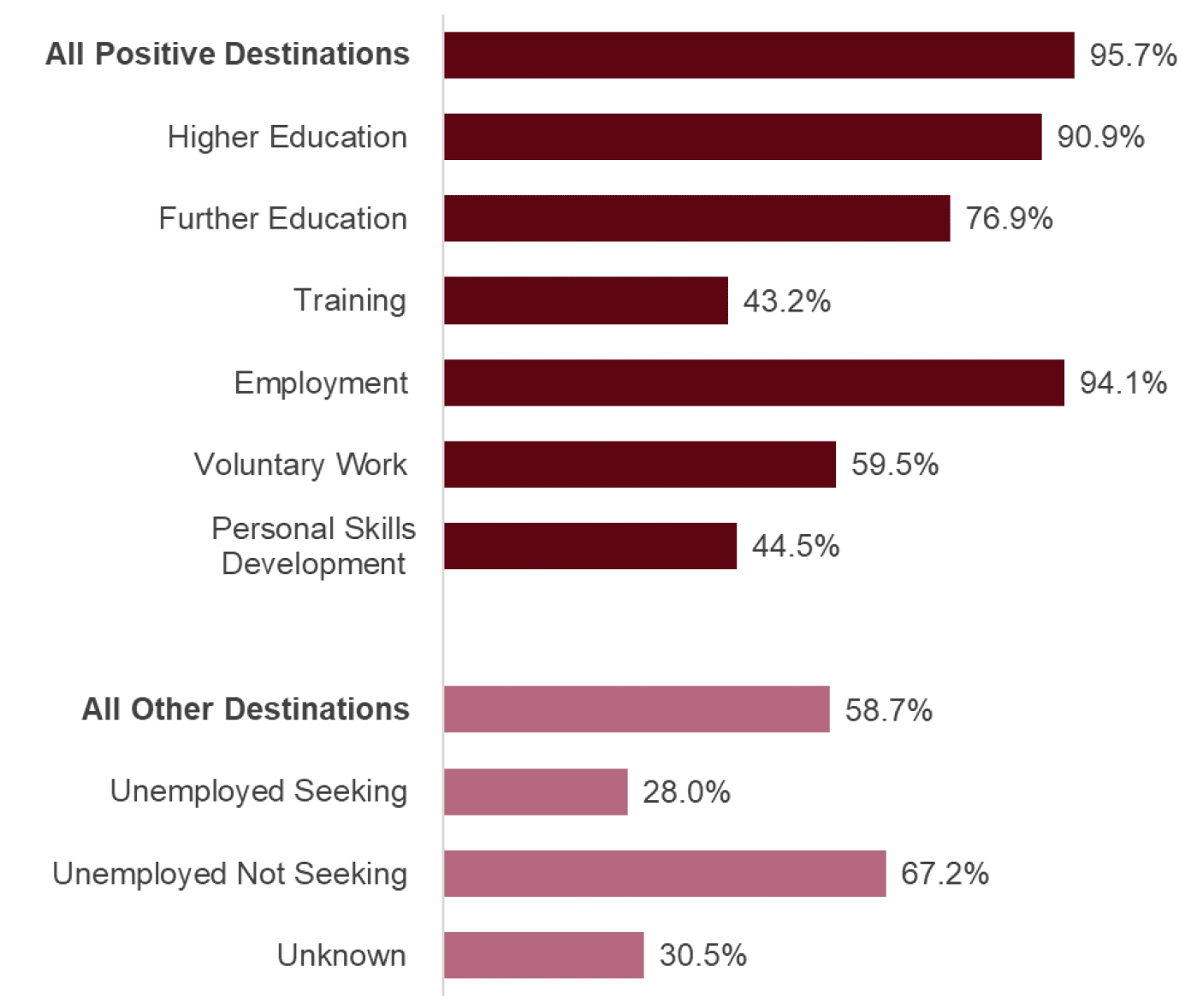Summary statistics for follow-up leaver destinations, no. 5: 2023 edition
This statistical publication provides information on the follow-up destinations of 2021/22 school leavers from publicly funded secondary schools in Scotland.
This document is part of a collection
Chapter 3: Initial to follow-up destination comparison
- 95.7 per cent of 2021/22 school leavers who were in a positive initial destination were also in a positive follow-up destination.
- Employment was the most sustained destination in 2021/22. Of the 2021/22 leavers who were in Employment as their initial destination, 94.1 per cent were still in Employment as their follow-up destination.
3.1 Initial and follow-up destinations
A school leaver's follow-up destination, nine months after they leave school, may differ from their initial destination, three months after they leave school. Information on the initial destinations of 2021/22 school leavers was published in February 2023.
Chart 3 compares 2021/22 school leaver initial destination rates (three months after leaving school) with follow-up destination rates (nine months after leaving school).
The percentage of 2021/22 school leavers in a positive follow-up destination (93.5 per cent) was lower than the percentage of school leavers in a positive initial destination (95.7 per cent). The same pattern can be seen across all previous school leaver cohorts since consistent records began in 2009/10.
In 2021/22, the largest reductions between initial and follow-up destinations were in Further Education and Higher Education. The percentage of leavers in these destinations decreased by 4.7 and 3.6 percentage points respectively between initial and follow-up. Analysis of leavers changing destinations (available in Table L1.8 of the supplementary tables) shows that the most common follow-up destination for those leaving Higher and Further Education was Employment.
The largest increase between initial destination and follow-up destination was in Employment. The proportion of leavers in this destination increased by 6.7 percentage points between initial destination and follow-up destination.
These patterns are broadly consistent with those seen in most years since 2009/10.
The proportion of leavers in 'other' destinations (see section 1.1) increased by 2.2 percentage points between initial and follow-up destinations. Within this the percentage of Unemployed Seeking increased by 1.1 percentage points.
A time series of initial and follow-up destinations is available in the supplementary tables. A list of these tables is available in section 4.11.

Note 16: Bars in chart 3 which are white on the inside with a coloured outline show data on initial destinations of leavers. Bars which are a solid colour show data on follow-up destinations. The darker colour (used in the top portion of the chart) shows positive destinations, while the lighter colour (used in the lower portion) shows 'other' destinations.
3.2 Leavers sustaining or changing destination
Chart 4 shows the percentage of 2021/22 school leavers whose follow-up destination was the same as their initial destination. In 2021/22, 95.7 per cent of those in a positive initial destination were also in a positive follow-up destination. This includes leavers in the same positive destination, and those who moved to an alternative positive destination. This is a slight increase from 2020/21, when 95.5 per cent of leavers in a positive initial destination were also in a positive follow-up destination.
The positive destination in which 2021/22 school leavers were most likely to remain between initial and follow-up was Employment, at 94.1 per cent; followed by Higher Education at 90.9 per cent. Of those leavers who were in Further Education as their initial destination, 76.9 per cent were still in Further Education at follow-up. This follows the same pattern as 2020/21, when Employment was the positive destination leavers were most likely to sustain (94.2 per cent), followed by Higher Education (88.8 per cent) and Further Education (74.0 per cent). However the proportions of leavers remaining in Higher Education and Further Education between initial and follow-up was higher in 2021/22 than in 2020/21.
School leavers whose initial destination was Personal Skills Development or Training were less likely to remain in the same destination between initial and follow-up. Amongst leavers whose initial destination was Training, 43.2 per cent were still in Training as their follow-up destination, and 44.5 per cent of those in Personal Skills Development at initial were still in Personal Skills Development at follow-up. This may be due, in part, to the short-term nature of some of these activities (see section 4.6).

Table L1.8 in the supplementary tables provides information on school leavers staying in their initial destination or moving to an alternative destination. For example, it shows that for those leaving Higher Education and Further Education in 2021/22, the most common follow-up destination was Employment. Of those whose initial destination was Higher Education, 6.8 per cent had moved into Employment as their follow-up destination. Of those whose initial destination was Further Education, 13.4 per cent had moved into Employment.
Table L1.8 in the supplementary tables also shows that for those leaving Training and Personal Skills Development in 2021/22, the most common follow-up destination was also Employment. In 2021/22, of those whose initial destination was Training, 23.4 per cent had entered Employment as their follow-up destination and 10.1 per cent had entered Further Education. Of those whose initial destination was Personal Skills Development, 16.6 per cent had entered Employment at follow-up and 13.8 per cent had entered Training.
More information on school leavers who sustained a destination or moved into an alternative destination is available in table L1.8 of the supplementary tables.
3.3 Leavers sustaining or changing destination, by stage
Table 4 shows, for each stage of leaving, the number of leavers by category of initial destination (positive or 'other'), and the percentage of those who sustained or changed category by the time of follow-up.
S4 leavers were the least likely to sustain a positive destination between initial and follow-up. Of the 6,293 leavers from S4 who were in a positive initial destination, 90.8 per cent were still in a positive destination at follow-up, and 8.8 per cent had moved to an 'other' destination. S6 leavers were the most likely to sustain a positive destination. Of the 32,203 leavers from S6 who were in a positive initial destination, 97.3 per cent were still in a positive destination at follow-up, and 2.6 per cent had moved to an 'other' destination.
S4 leavers were the most likely to remain in an 'other' destination between initial and follow-up. Of the 570 leavers from S4 who were in an 'other' initial destination, 60.5 per cent were still in an other destination at follow-up, and 38.2 per cent had moved to a positive destination. S6 leavers were the most likely to leave an 'other' destination for a positive destination. Of the 836 leavers from S6 who were in an 'other' initial destination, 56.3 per cent were still in an 'other' destination at follow-up, and 42.9 per cent had moved to a positive destination.
| Stage of leaving | S4 | S5 | S6 | All leavers |
|---|---|---|---|---|
| Number of initial leavers: | 6,863 | 15,308 | 33,039 | 55,237 |
| Number in a positive initial destination: | 6,293 | 14,363 | 32,203 | 52,879 |
| Of whom, percent still in a positive destination at follow-up: | 90.8 | 94.2 | 97.3 | 95.7 |
| Of whom, percent who moved to an 'other' follow-up destination: | 8.8 | 5.7 | 2.6 | 4.2 |
| Number in an 'other' initial destination: | 570 | 945 | 836 | 2,358 |
| Of whom, percent still in an 'other' destination at follow-up: | 60.5 | 59.6 | 56.3 | 58.7 |
| Of whom, percent who moved to a positive follow-up destination: | 38.2 | 40.0 | 42.9 | 40.6 |
Note 17: A small number of leavers in the initial leaver cohort were from other stages (S3 and other). For more information see tables C1.1a and C1.1b in the supplementary tables to the Summary Statistics for Attainment and Initial Leaver Destinations. Data for these leavers is not shown here due to small counts.
Note 18: A small number of leavers from the initial leaver cohort are excluded from the follow-up cohort. See section 4.4 for more information. For this reason percentages may not sum to 100 per cent.
Contact
Email: school.stats@gov.scot
There is a problem
Thanks for your feedback